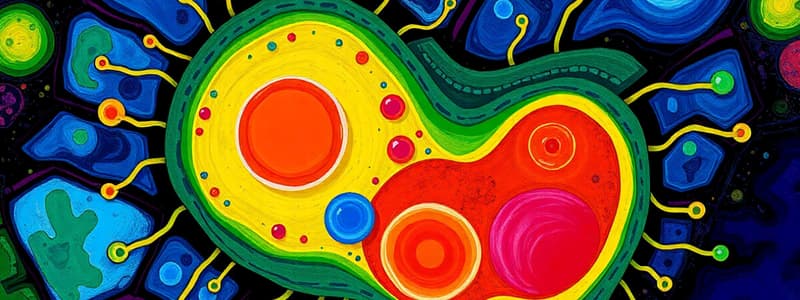Podcast
Questions and Answers
Which of these is NOT a key molecule studied in biochemistry?
Which of these is NOT a key molecule studied in biochemistry?
What is the primary function of enzymes in biological systems?
What is the primary function of enzymes in biological systems?
Which of these is NOT a characteristic of a biome?
Which of these is NOT a characteristic of a biome?
Which of these levels of classification represents the broadest (most inclusive) grouping?
Which of these levels of classification represents the broadest (most inclusive) grouping?
Signup and view all the answers
Which of the following is NOT a core theme in biology?
Which of the following is NOT a core theme in biology?
Signup and view all the answers
What is the primary difference between prokaryotic and eukaryotic cells?
What is the primary difference between prokaryotic and eukaryotic cells?
Signup and view all the answers
Which cellular process is responsible for the conversion of light energy into chemical energy?
Which cellular process is responsible for the conversion of light energy into chemical energy?
Signup and view all the answers
What is the role of DNA replication in cell division?
What is the role of DNA replication in cell division?
Signup and view all the answers
Which of the following is NOT a characteristic of genes?
Which of the following is NOT a characteristic of genes?
Signup and view all the answers
What is the main mechanism driving evolution?
What is the main mechanism driving evolution?
Signup and view all the answers
What is the relationship between adaptation and natural selection?
What is the relationship between adaptation and natural selection?
Signup and view all the answers
Which of the following is NOT a factor contributing to genetic diversity within populations?
Which of the following is NOT a factor contributing to genetic diversity within populations?
Signup and view all the answers
Flashcards
Ecology
Ecology
The study of interactions between organisms and their environment.
Ecosystem
Ecosystem
A complex community of organisms and their physical environment.
Biodiversity
Biodiversity
The variety of life in a specific area.
Enzymes
Enzymes
Signup and view all the flashcards
Microbiology
Microbiology
Signup and view all the flashcards
Prokaryotic cells
Prokaryotic cells
Signup and view all the flashcards
Eukaryotic cells
Eukaryotic cells
Signup and view all the flashcards
Cellular respiration
Cellular respiration
Signup and view all the flashcards
Photosynthesis
Photosynthesis
Signup and view all the flashcards
Mitosis
Mitosis
Signup and view all the flashcards
Natural selection
Natural selection
Signup and view all the flashcards
Speciation
Speciation
Signup and view all the flashcards
Study Notes
Introduction to Biology
- Biology is the scientific study of life and living organisms, from the smallest molecules to the largest ecosystems.
- Core themes include evolution, genetics, cell biology, energy flow, and interactions among organisms.
- Branches include botany (plants), zoology (animals), microbiology, ecology, and more.
- Biology relies on observation, experimentation, and developing testable hypotheses.
Cell Structure and Function
- Cells are the fundamental units of life.
- Prokaryotic cells lack a nucleus and membrane-bound organelles.
- Eukaryotic cells have a nucleus and membrane-bound organelles like mitochondria and endoplasmic reticulum.
- Specialized organelles perform specific functions.
- Cell membranes control material passage.
Cellular Processes
- Cellular respiration releases energy from food molecules.
- Photosynthesis converts light energy to chemical energy in plants and some organisms.
- Mitosis creates two identical daughter cells.
- Meiosis produces four genetically unique daughter cells.
- DNA replication ensures accurate genetic information for cell division.
Genetics
- Genes are DNA segments directing protein production.
- DNA is a double helix structure carrying genetic information.
- Genetics involves inheritance patterns, mutations, and genetic engineering.
- Chromosomes are DNA and protein structures carrying genetic material.
- Genetic diversity creates variation within populations.
Evolution
- Evolution is the change in heritable traits of biological populations over generations.
- Natural selection is a key mechanism where advantageous traits increase survival and reproduction.
- Adaptation improves organismal fitness in an environment.
- Common ancestry explains shared traits among species.
- Speciation forms new and distinct species.
Ecology
- Ecology studies interactions between organisms and their environment.
- Ecosystems are communities of organisms and their physical environment.
- Food webs display energy and nutrient flow within ecosystems.
- Biodiversity is the variety of life in an area.
- Biomes are large areas with similar climates and characteristic life.
Classification of Living Organisms
- Organisms are classified hierarchically based on evolutionary relationships.
- The system uses domains, kingdoms, phyla, classes, orders, families, genera, and species.
- This system helps organize the vast diversity of life.
Biochemistry
- Biochemistry examines chemical processes in living organisms.
- Key molecules include carbohydrates, lipids, proteins, and nucleic acids.
- These molecules have crucial structures and functions.
- Enzymes are biological catalysts speeding up reactions.
Microbiology
- Microbiology studies microscopic organisms: bacteria, viruses, fungi, and protists.
- Different groups have varied characteristics and roles in the environment and human health.
- Microbiology is important for understanding disease and public health.
Studying That Suits You
Use AI to generate personalized quizzes and flashcards to suit your learning preferences.
Description
Explore the foundational aspects of biology, focusing on the diversity of life forms and the critical role of cells. Understand the differences between prokaryotic and eukaryotic cells, and the functions of various organelles. This quiz will challenge your knowledge on essential biological themes and concepts.




